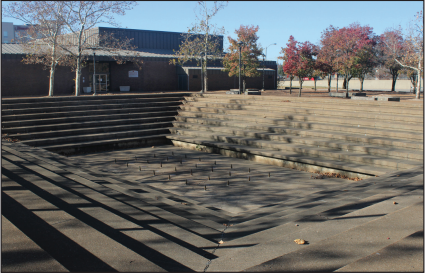
Some wish it could spray water again
By Precious Kenney
The Scene staff
Many Forest Park students and employees don’t even know that the campus was built around a giant sunken fountain in the quad.
That’s because plumbing problems have kept it from spraying water for more than 10 years. Now the college is planning to fill it with dirt and vegetation.
“There’s very little green space, and students do like to sit on that side of the campus,” President Julie Fickas said. “And we want to make sure that there’s some opportunity to see green and not just aggregate.”
Fickas said the dry fountain’s depth and steep steps also have caused safety concerns.
In the early 2010s, officials were hoping to fix the fountain, but they said the college didn’t have enough money in the facilities budget at the time. They didn’t say how much it would cost.
Now officials expect to spend about $350,000 to fill in the fountain, according to Jeff Blankenship, construction project facilitator in the St. Louis Community College engineering and design department.
Blankenship, Fickas and Jason Young, Forest Park communications coordinator, said this month they didn’t know how much it would cost to repair the fountain.
“I’m not sure when it stopped working,” said Blankenship, who joined STLCC in January. “But I guess it was going to cost too much money to fix. It was just old equipment, and it was leaking.”

Some students and employees support the college’s plan to eliminate the fountain. One is Logan Canaday, president of the Student Government Association.
Canaday became involved in SGA at the beginning of fall semester because he wanted to see changes, including those that would make the campus more attractive.
“I’m happy about the fountain being filled,” he said. “I think if there’s one thing on campus that we are lacking (it’s) good green space.
“I think the campus is pretty barren. I mean, we have trees and stuff, but there’s just a lot of concrete. So yeah, I think it’s going to look good.”
Other students and employees would prefer to see the fountain repaired and functional.
Reference Librarian Joseph Rogers, who has worked at Forest Park for 15 years, remembers the fountain being a beautiful focal point. People used to sit around it and study or socialize, particularly on warm days.
Rogers noted that other fountains in the St. Louis area have been named for individuals and companies who provided funding in exchange for exposure.
“It might be a possibility for the fountain here, too, to get a sponsor and then name it after the person,” he said. “I would think St. Louis Community College has many very successful, financially successful graduates, as well as artistically successful ones, sometimes both. One of them might like to have a fountain named after them.
“Then you just put the money into it, and hopefully it will attract enough new students to pay for itself. And if we had a sponsor paying for it, it would turn a tidy profit for it, and just use that money and lower everybody’s tuition.”
The once-iconic fountain is south of Oakland Avenue, east of the theater building, north of the West Wing and west of the library. It was installed when the Forest Park campus was built in the 1960s.

The fountain measures 60 by 80 feet around the top. Nine concrete steps lead down to a rectangular basin with 28 nozzles that sprayed water into the air for decades. It was illuminated by colorful lights.
The Scene published a story on the fountain in 2014. John Vansahgi, who was manager of buildings and grounds at the time, blamed its plumbing problems on rusty and deteriorating cast-iron pipes that leaked water underground and raised utility bills.
“We just don’t have the funding to get it fixed,” he said.
Fickas announced in a recent employee newsletter that the college was poised to fill the fountain with soil and vegetation, an idea that originated with STLCC Chancellor Jeff Pittman.
Officials are now planning the project, which will consist of both infrastructure and landscaping work, according to Blankenship. They expect bidding in January, construction in February and completion by March.
Blankenship said the new green space might include benches and tables to make it more inviting for students to spend time outside.
Fickas described it as a “grassy area.” She noted that the college has adopted a policy of moving toward sustainable landscaping in recent years.
“When you have all that concrete, that’s not permeable to water,” said Fickas, a trained biologist. “There’s a lot of runoff, and so one of the things that we could do to prevent that runoff into the sewer system is to collect that water with the grass. That makes us a more sustainable institution.”
Forest Park Librarian Ashley Foster is skeptical that the college will follow through with the fountain plan. She said other plans in the past haven’t materialized. “They sent it out in an email two years ago, saying they have a plan for it,” Foster said. “They showed it all redesigned. “(It was a) full picture, but nothing ever happened with it.”

Most students randomly interviewed by The Scene this fall had no idea that Forest Park used to have a fountain in the quad. “It’s been pretty dried up for forever,” said Javier Delgado, 26, a general transfer studies student.
Several students suggested turning the Delgado Hasein fountain into an amphitheater for outdoor plays and concerts.
Nursing student Khalel Hasein, 38, has nicknamed it “the Roman theater.” He uses the area as a quiet place to hang out, but he pointed out that he rarely sees others sitting on the steps.
“It looks nice, but there is no kind of activity down here,” Hasein said. “So maybe it can actually be some kind of space for some kind of activities, and people can sit and watch.”
Like Rogers, former student Garrieth Crockett, 32, who was visiting campus recently, remembers when the fountain was functioning, and it gives him a feeling of nostalgia.
“Ideally, I’d like see it as a fountain again.” he said. “I found that it was a nice aesthetic piece. … I think for me (the plan to convert it to green space is) expected because it’s just taking up space. I mean that could be walking space. That could be another art piece, right? There could be so many other things rather than what it is.”
